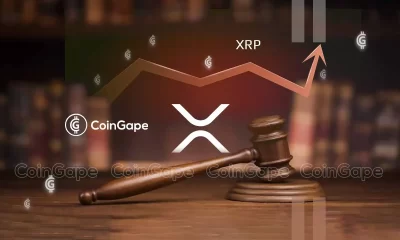24/7 Cryptocurrency News
Ripple CEO Brad Garlinghouse Calls $11B Valuation Outdated Amid XRP Price Surge
Published
2 days agoon
By
admin
Ripple CEO Brad Garlinghouse has declared that Ripple’s previous valuation of $11 billion is now “very outdated,” following a notable surge in XRP price and increased demand for Ripple’s blockchain solutions.
Speaking during a recent interview, Garlinghouse cited the company’s substantial holdings of XRP, now valued at over $100 billion, as a key factor altering Ripple’s valuation outlook.
Ripple CEO Brad Garlinghouse Calls $11B Valuation Outdated
According to Ripple CEO Brad Garlinghouse the company now has more than $100 billion worth of XRP tokens. This development changes the valuation proposition of the blockchain infrastructure company dramatically. The CEO noted that Ripple’s trading in private markets has been much cheaper to the net asset value of the company than other companies that are linked to cryptocurrencies such as MicroStrategy.
“The total value of the XRP we hold is now greater than $100 billion,” said Garlinghouse. He also compared Ripple’s valuation metrics with MicroStrategy noting that the latter trades at a premium to its assets. ”Ripple has been trading in the private markets at a discount while MicroStrategy has trading at 3x premium to its net asset value,” he said.
Ripple was last valued at $11 billion in early 2024 when the company bought back $300 million worth of shares. Nevertheless, Ripple CEO Brad Garlinghouse stated that such an estimate is no longer relevant to the current financial position of Ripple, thanks to the increasing XRP price and institutional adoption.
XRP Price Growth Attracts Attention Amid Market Trends
XRP price has also seen a significant rise in value, it has risen five times its value before the election periods in late 2024. Ripple’s token has had increased liquidity and trading volume, sometimes even outperforming Bitcoin, as per data from FalconX.
This upsurge is in line with other developments within the cryptocurrency market such as the high probability of a crypto ETF launch and debate on a U.S. based blockchain reserve. Crypto analyst Peter Brandt noted in his recent analysis of XRP’s technical chart that if the current bullish flag pattern would be fulfilled, XRP market cap may hit $500 billion.
Furthermore, the SuperTrend indicator has just turned bullish on the XRP 12-hour chart for the first time in several months. Analyst Ali Charts pointed out that “The last time the SuperTrend indicator changed direction to the bullish side, XRP rose by 470%.”
Ripple CEO Stance on Company Strategic Focus
Although XRP is gaining popularity in the market, Ripple’s main business is still centered on offering blockchain technologies to financial companies. In the interview, Ripple CEO Brad Garlinghouse restated his company’s focus on the B2B sector including banks, payment providers, and corporates, where Ripple is offering solutions like custody and cross-border payments.
Recently, Ripple announced that it would launch its stablecoin called Ripple USD (RLUSD) with the license from the New York Department of Financial Services (NYDFS). Garlinghouse stressed that the RLUSD will leverage XRP rather than replace it, increasing its liquidity, and opening more possibilities for the utilization of Ripple’s DEX and automated market maker (AMM) functionalities.
The acquisition of Switzerland-based custody firm Metaco which was completed about 18 months ago has also put Ripple in a vantage position to offer its institutional products. The CEO was upbeat on the increased demand of the company’s custody services especially from Tier 1 banks.
Changing Regulatory Environment Fuels Optimism
Ripple’s growth has been supported by changing perceptions in the legal environment. Garlinghouse claimed that the previous several months marked a ‘turning point’ due to the exit of SEC Chairman Gary Gensler and the chance for regulatory certainty under the new administration.
As a result of the recent changes in the US government’s stance with regard to cryptocurrency innovation, Ripple CEO Brad Garlinghouse said, “The winds have changed.”
Recently, he also stated that 95% of Ripple’s customers are outside the United States, but he expects the interest to return in the United States in the next few months.
Kelvin Munene Murithi
Kelvin is a distinguished writer with expertise in crypto and finance, holding a Bachelor’s degree in Actuarial Science. Known for his incisive analysis and insightful content, he possesses a strong command of English and excels in conducting thorough research and delivering timely cryptocurrency market updates.
Disclaimer: The presented content may include the personal opinion of the author and is subject to market condition. Do your market research before investing in cryptocurrencies. The author or the publication does not hold any responsibility for your personal financial loss.
Source link
You may like


ChatGPT’s top 5 crypto picks for the 2025 market surge


XRP Flashing Bullish Signal That Previously Triggered 470% Upside Burst, According to Analyst Ali Martinez


FTX Breaks Silence On Backpack’s Alleged Acquisition Of The Defunct Exchange


Steve Hanke Is Wrong About the Strategic Bitcoin Reserve


Shiba Inu may not reach $1, here’s the token to make millionaires in 2025


70 Million DOGE Make Their Way To Binance Amid 10% Dogecoin Price Crash
24/7 Cryptocurrency News
FTX Breaks Silence On Backpack’s Alleged Acquisition Of The Defunct Exchange
Published
2 hours agoon
January 9, 2025By
admin
FTX issued a formal statement clarifying details surrounding Backpack entities’ claim of acquiring FTX EU Ltd. The clarification, released on January 8, 2025, addresses inaccuracies in Backpack’s January 7 press release, which suggested its involvement in asset recovery for former FTX EU customers.
FTX Highlights Inaccuracy in Backpack’s FTX EU Acquisition Statements
In a recent press release, FTX addressed statements made by Backpack entities regarding its purported acquisition of FTX EU. FTX stated that the January 7, 2025, Backpack announcement was made without FTX’s knowledge or involvement. According to the exchange, Backpack’s press release contain multiple inaccuracies that could mislead stakeholders.
FTX emphasized that 100% of FTX EU share capital is still owned by FTX Europe AG, a subsidiary of FTX. While there was an earlier agreement to sell FTX EU to former insiders of FTX Europe as part of a settlement, the U.S. Bankruptcy Court overseeing the Chapter 11 process has not approved any transfer. The defunct exchange also confirmed that it was unaware of any indirect sale of FTX EU shares to Backpack before this week.
Bankruptcy Court and Asset Recovery Process
In addition, the defunct exchange clarified that Backpack has no role in the U.S. Bankruptcy Court-approved process for returning funds to creditors, including FTX EU’s former customers. The company reiterated that only FTX EU holds responsibility for determining and returning funds owed to its customers. The court’s Chapter 11 plan does not authorize the organization to make distributions to any creditors or former customers.
The defunct exchange further stated that the amounts owed by FTX EU to its customers would be assessed solely by FTX EU following its sale, not by the exchange or the Bankruptcy Court. Therefore, the exchange disclaimed Backpack’s liability for repayments of EU customer funds.
Furthermore, the defunct exchange expressed concerns about the accuracy and completeness of the information presented in Backpack’s materials. The report urged stakeholders to rely only on official FTX communications.
Initial Distributions Under Bankruptcy Plan
The defunct exchange also provided an update on its U.S. Bankruptcy Court-approved Chapter 11 plan of reorganization. The defunct exchange plan became effective on January 3, 2025, with the initial distribution record date set for the same day. Distributions to convenience class claimants are expected within 60 days, subject to regulatory requirements.
Meanwhile, the exchange reaffirmed its commitment to adhering to the court’s processes and ensuring accurate communication with creditors.
These developments come in light of recent media speculation that US President Joe Biden might pardon Sam Bankman-Fried, the founder of the defunct FTX Exchange. Biden’s recent pardon of his son has sparked further rumors that SBF could get the same treatment.
Ronny Mugendi
Ronny Mugendi is a seasoned crypto journalist with four years of professional experience, having contributed significantly to various media outlets on cryptocurrency trends and technologies. With over 4000 published articles across various media outlets, he aims to inform, educate and introduce more people to the Blockchain and DeFi world. Outside of his journalism career, Ronny enjoys the thrill of bike riding, exploring new trails and landscapes.
Disclaimer: The presented content may include the personal opinion of the author and is subject to market condition. Do your market research before investing in cryptocurrencies. The author or the publication does not hold any responsibility for your personal financial loss.
Source link
24/7 Cryptocurrency News
Terraform Co-Founder Do Kwon’s Trial To Begin In 2026
Published
6 hours agoon
January 8, 2025By
admin
The U.S. criminal fraud trial of Do Kwon, co-founder and former CEO of Terraform Labs, has been scheduled to begin in January 2026. The decision was announced during an initial hearing in Manhattan, as prosecutors and defense attorneys prepare to review an extensive six-terabyte trove of evidence.
Here’s Why Terraform Co-Founder Do Kwon’s Trial Is Delayed Until 2026
According to a recent report from Manhattan’s Southern District Court, the criminal fraud trial of Terraform Co-Founder Do Kwon has been tentatively set for January 2026. This extended timeline accommodates the need for both prosecution and defense to thoroughly review the massive six-terabyte trove of data included in the discovery process.
Prosecutors noted several challenges that contributed to the delay, including difficulties unlocking four cell phones provided by Montenegrin authorities during Kwon’s extradition. Additionally, the data extracted from these devices requires translation from Korean into English.
Therefore, accessing and interpreting data has posed unique hurdles. The encrypted cell phones are expected to contain crucial evidence related to the charges against the Terraform Co-Founder.
This Is a Developing Story, Please Check Back For More
Ronny Mugendi
Ronny Mugendi is a seasoned crypto journalist with four years of professional experience, having contributed significantly to various media outlets on cryptocurrency trends and technologies. With over 4000 published articles across various media outlets, he aims to inform, educate and introduce more people to the Blockchain and DeFi world. Outside of his journalism career, Ronny enjoys the thrill of bike riding, exploring new trails and landscapes.
Disclaimer: The presented content may include the personal opinion of the author and is subject to market condition. Do your market research before investing in cryptocurrencies. The author or the publication does not hold any responsibility for your personal financial loss.
Source link
24/7 Cryptocurrency News
How Will Donald Trump’s Tariff Plans Impact The Crypto Market?
Published
10 hours agoon
January 8, 2025By
admin
President-elect Donald Trump is reportedly considering declaring a national economic emergency to implement a universal tariff program targeting allies and adversaries. These tariffs, potentially introduced under the International Economic Emergency Powers Act (IEEPA), will realign global trade balances.
Meanwhile, Federal Reserve Governor Christopher Waller addressed concerns about inflation and the potential economic ramifications of such tariffs. This development raises questions about how these policies may influence the cryptocurrency market.
Donald Trump’s Tariff Strategy
As reported by CNN, President-elect Donald Trump is considering the International Economic Emergency Powers Act (IEEPA) to implement tariffs. The intended tariffs are to rebalance global trade while focusing on the manufacturing sector in the United States. Trump’s preference for IEEPA lies in its flexibility, allowing swift implementation without needing extensive national security justification.
Supporters of the tariffs argue they could rebuild American industrial capacity and strengthen the economy. However, the uncertainty surrounding the scope and execution of these tariffs could ripple through global financial markets. This may influence investor behavior in emerging sectors like the crypto market.
Donald Trump’s deputy assistant for International Economic Affairs, Kelly Ann Shaw, commented,
“I think the president has broad authority to impose tariffs for a variety of reasons, and there are a number of statutory bases to do so.”
Federal Reserve’s Perspective on Tariffs and Inflation
Concurrently, Federal Reserve Governor Christopher Waller has addressed the possible inflationary risks associated with Trump’s tariff proposals. Waller noted that while inflation stalled above the Fed’s 2% target in late 2024, he remains optimistic about a gradual decline in 2025. He added that increased tariffs are unlikely to cause persistent inflation, decoupling their potential effects from broader economic trends.
Waller stated,
“I will support further cuts in 2025, but the pace will depend on further inflation progress. I don’t expect tariffs to have a significant impact on inflation.”
The Federal Reserve lowered interest rates by 25 basis points at the end of 2024, and more cuts will follow based on the inflation rate. The outlook indicates that monetary policy could continue with an accommodative stance in the year 2025. This will support financial markets, including cryptocurrencies, to improve liquidity and investment flow.
Implications of Tariffs on The Cryptocurrency Market
If the Fed cuts interest rates further, as expected by the market, then there is the possibility that more funds could flow into the crypto market for better returns. Usually, such rate cuts fuel risk-on sentiment, so assets such as crypto benefit from it.
However, Donald Trump’s tariff policies may create broader trade uncertainties. This may indirectly influence the crypto market through changes in global economic confidence.
Trade disruptions could lead to diminished faith in traditional financial systems, potentially encouraging a shift toward decentralized digital assets like Bitcoin and Ethereum. On the other hand, if tariffs introduce unforeseen inflationary pressures, the Federal Reserve might pause or reverse rate cuts, which could dampen optimism in the crypto market.
The Federal Reserve and broader economic concerns have been among the major reasons for the cryptocurrency market crash. Rising U.S. Treasury yields and a hawkish Fed stance have fueled risk-off sentiment, drawing capital away from cryptocurrencies.
Ronny Mugendi
Ronny Mugendi is a seasoned crypto journalist with four years of professional experience, having contributed significantly to various media outlets on cryptocurrency trends and technologies. With over 4000 published articles across various media outlets, he aims to inform, educate and introduce more people to the Blockchain and DeFi world. Outside of his journalism career, Ronny enjoys the thrill of bike riding, exploring new trails and landscapes.
Disclaimer: The presented content may include the personal opinion of the author and is subject to market condition. Do your market research before investing in cryptocurrencies. The author or the publication does not hold any responsibility for your personal financial loss.
Source link
ChatGPT’s top 5 crypto picks for the 2025 market surge
XRP Flashing Bullish Signal That Previously Triggered 470% Upside Burst, According to Analyst Ali Martinez
FTX Breaks Silence On Backpack’s Alleged Acquisition Of The Defunct Exchange

Steve Hanke Is Wrong About the Strategic Bitcoin Reserve
Shiba Inu may not reach $1, here’s the token to make millionaires in 2025
70 Million DOGE Make Their Way To Binance Amid 10% Dogecoin Price Crash
Terraform Co-Founder Do Kwon’s Trial To Begin In 2026

The Lightning Network Privacy Big Picture: Don't Forget the NSA
Digital banking giant Revolut joins Pyth Network
‘Very Dubious’ Speculation Suggests Bitcoin Could Follow Nasdaq ETF Rallies of 1999: Benjamin Cowen
How Will Donald Trump’s Tariff Plans Impact The Crypto Market?
Ledn Remains Bitcoin’s Premier Borrowing And Lending Platform
Analysts says Solana price to pass $500 In Q1, while this altcoin could rally 2,000%
Pakistani Trader Kidnapped, Forced to Hand Over $340,000 in Crypto
Will BTC Recover After 2025’s First Crash?

Ethereum’s lowered yield might signal a paradigmatic shift in the ecosystem

Telegram users can send gifts to friends, TON fails to pump

Bitcoin Could Rally to $80,000 on the Eve of US Elections

Institutional Investors Go All In on Crypto as 57% Plan to Boost Allocations as Bull Run Heats Up, Sygnum Survey Reveals

Crypto’s Big Trump Gamble Is Risky

Arthur Hayes, Murad’s Prediction For Meme Coins, AI & DeFi Coins For 2025

A Kamala Presidency Could Be Just as Bullish for Bitcoin

Ripple-SEC Case Ends, But These 3 Rivals Could Jump 500x

SEC filing underway, Bitcoin rewards app Fold adopts FLD ticker

Cardano and the XRP price action lock in bulls vs bears battle as RCO Finance prepares for 3,000% surge

A16z-backed Espresso announces mainnet launch of core product

Tether CEO Paolo Ardoino Denies Rumors That Stablecoin Issuer Is Under Federal Investigation

Crypto Exchange OKX Moves To Support USDC Ecosystem by Adding Six New Trading Pairs

Trump’s Coin Is About As Revolutionary As OneCoin

Ripple Vs. SEC, Shiba Inu, US Elections Steal Spotlight
Trending

 DeFi3 months ago
DeFi3 months agoEthereum’s lowered yield might signal a paradigmatic shift in the ecosystem

 News3 months ago
News3 months agoTelegram users can send gifts to friends, TON fails to pump

 Bitcoin2 months ago
Bitcoin2 months agoBitcoin Could Rally to $80,000 on the Eve of US Elections

 Bitcoin2 months ago
Bitcoin2 months agoInstitutional Investors Go All In on Crypto as 57% Plan to Boost Allocations as Bull Run Heats Up, Sygnum Survey Reveals

 Opinion2 months ago
Opinion2 months agoCrypto’s Big Trump Gamble Is Risky

 24/7 Cryptocurrency News2 months ago
24/7 Cryptocurrency News2 months agoArthur Hayes, Murad’s Prediction For Meme Coins, AI & DeFi Coins For 2025

 Opinion3 months ago
Opinion3 months agoA Kamala Presidency Could Be Just as Bullish for Bitcoin

 Price analysis2 months ago
Price analysis2 months agoRipple-SEC Case Ends, But These 3 Rivals Could Jump 500x




✓ Share: